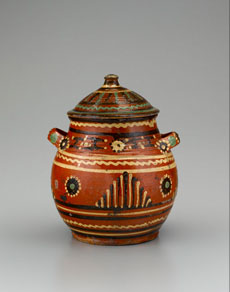Art in Clay: Masterworks of North Carolina Earthenware
Decorative Arts Gallery
Slipware, sculptural bottles, faience, and creamware are all part of the rich artistic legacy of North Carolina’s first earthenware potters. During the last half of the eighteenth century, artisans of European descent introduced a variety of old-world ceramic traditions to the Carolina backcountry. From storage and cooking vessels with deeply rooted antecedents to sophisticated ornamental ware with Islamic, Asian, and European overtones, the work of these artisans was as diverse as the culture it helped sustain. North Carolina potters transformed the simplest of materials into vessels of practical utility, astonishing beauty, and cultural and religious significance.
Art in Clay is the first major survey of these earthenware traditions and features more than 150 objects. The exhibition explores, among others, work related to the multi-generational Loy family tradition, which originated in France, and that by Moravian immigrant potters who were trained (or influenced) by Gottfried Aust. Aust (American, b. Germany, 1722–1788) was a master potter trained in Saxony, Germany, who later found a home in the North Carolina Moravian missionary settlement. Superior in quality to the pottery the early American colonists were creating, the slip-decorated earthenware, though utilitarian, represented the religious beliefs for which their makers had once been persecuted, and allowed the settlers to maintain a sense of cultural identity in the new world.
- Sugar Pot, Alamance County, North Carolina, 1790–1800. Lead-glazed earthenware. H. 10 in. Courtesy, Old Salem Museums & Gardens. Photo by Gavin Ashworth.

